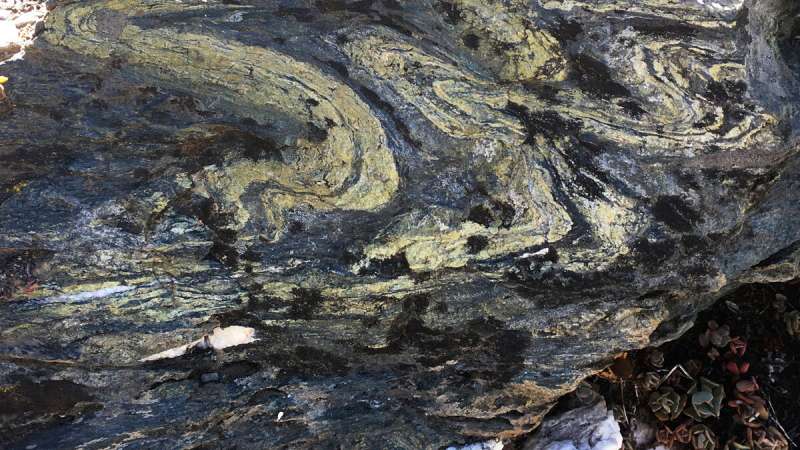Unearthing the cause of slow seismic waves in subduction zones

In modern subduction zones—regions around the world that have one tectonic plate sliding past another—one area can act like molasses for seismic waves. These anomalous areas are called low-velocity zones, or LVZs. In these zones, seismic waves are up to three times slower than waves that whiz through the surrounding rock. Some scientists suggest that the slowdown is because the downgoing plate maintains an undeformed top layer, whereas other researchers propose that intense deformation between the two huge plates causes LVZs.
In a new study, Tewksbury-Christle and Behr attempted to unearth the causes of LVZs. While prior work has tended to rely on seismic wave investigation on rocks 25–50 kilometers deep, the team decided to study something accessible by car. They examined a fossil subduction zone in Northern California from the Late Jurassic to the Early Cretaceous that has since returned to the surface. The rocks are called the Condrey Mountain Schist (CMS), a metamorphic rock (greenschist/epidote-amphibolite to epidote-blueschist) that is also expected at depth in modern subduction zones.
The team tested the seismic velocity of the CMS in relation to the differences they observed in the subduction zone. They focused on the estimated width of the shear zone, the types of rocks within it, and the styles of deformation recorded by the rocks to determine what might affect the velocity in LVZs.
They found that the LVZ in the fossil subduction zone was about 3 kilometers wide—similar to modern subduction LVZs that range from 3 to 8 kilometers wide. They also looked at mineral orientation, or fabric, in the metasedimentary rock and found that the direction and alignment of the minerals can affect seismic velocity. Last, the porosity of fractured zones also contributed to the LVZ within the subducted rock.
The researchers conclude that LVZs in subduction zones mark where deformation between tectonic plates is occurring. They note that this study can help researchers better understand how plates move in subduction zones around the world.
More information: C. M. Tewksbury‐Christle et al, Constraints From Exhumed Rocks on the Seismic Signature of the Deep Subduction Interface, Geophysical Research Letters (2021). DOI: 10.1029/2021GL093831
Journal information: Geophysical Research Letters
Provided by American Geophysical Union
This story is republished courtesy of Eos, hosted by the American Geophysical Union. Read the original story here.




















